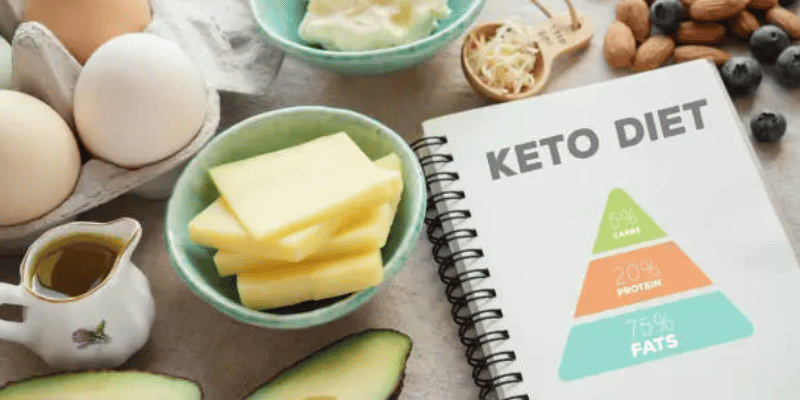So, you’ve made the decision to embark on the journey of the keto diet. Congratulations! Embracing this low-carb, high-fat lifestyle can lead to numerous health benefits, from weight loss to increased energy levels. However, starting a keto diet can be a bit daunting, especially if you’re unsure where to begin. But fear not, because in this article, we’ll guide you through the crucial first steps of your keto journey.
1. Introduction to the Keto Diet
Before diving into the specifics, let’s quickly recap what the keto diet entails. The ketogenic diet is a high-fat, moderate-protein, and low-carbohydrate eating plan designed to shift your body into a state of ketosis. In this metabolic state, your body burns fat for fuel instead of glucose, which can result in weight loss and improved overall health.
Read Also: Keto Vs. Intermittent Fasting: Which is better for lasting Weight Loss?
What is the Keto Diet?
The keto diet emphasizes consuming foods rich in healthy fats, such as avocados, nuts, seeds, and fatty fish, while minimizing your intake of carbohydrates, including grains, sugar, and starchy vegetables.
2. Understanding the First Steps
Setting Realistic Expectations
It’s essential to approach the keto diet with realistic expectations. While some people may experience rapid weight loss in the initial stages, others may take longer to adapt to the dietary changes. Remember that every individual’s body is different, so be patient with yourself as you adjust to this new way of eating.
Planning Your Meals
One of the keys to success on the keto diet is proper meal planning. Take some time to research keto-friendly recipes and create a meal plan for the week ahead. By planning your meals in advance, you can ensure that you have all the necessary ingredients on hand and avoid the temptation of reaching for non-keto foods when hunger strikes.
3. Starting the Keto Journey
Assessing Your Pantry
The first step in transitioning to a keto diet is to assess your pantry and refrigerator. Remove any high-carb foods such as bread, pasta, rice, and sugary snacks. Instead, stock up on keto-friendly staples like grass-fed butter, coconut oil, eggs, leafy greens, and low-carb vegetables.
Creating a Shopping List
Once you’ve cleared out the non-keto foods, it’s time to create a shopping list. Include plenty of fresh produce, high-quality meats, dairy products, and healthy fats. Having a well-stocked kitchen will make it easier to stick to your keto meal plan and resist the temptation of unhealthy snacks.
4. The First Thing to Do on a Keto Diet
Now that you’ve laid the groundwork for your keto journey, what’s the first thing you should do? The answer lies in your kitchen.
Making Keto-Friendly Substitutions
Replace high-carb ingredients with keto-friendly alternatives. For example, swap out regular flour for almond flour or coconut flour in your baking recipes. Use cauliflower rice instead of traditional rice, and opt for zucchini noodles instead of pasta. These simple substitutions will help you stay on track with your keto goals while still enjoying delicious meals.
Getting Rid of Temptation Foods
Remove any temptation foods from your kitchen that could derail your progress. This includes sugary snacks, processed foods, and carb-laden treats. By keeping your environment free of temptation, you’ll find it easier to stick to your keto meal plan and achieve your health and fitness goals.
5. Stocking Up on Essential Ingredients
To set yourself up for success on the keto diet, it’s essential to stock up on essential ingredients. Make sure you have plenty of healthy fats, such as olive oil, avocado oil, and grass-fed butter. Load up on protein sources like chicken, beef, fish, and tofu, and don’t forget to include a variety of low-carb vegetables to round out your meals.
6. Exploring Keto-Friendly Recipes
Don’t be afraid to get creative in the kitchen and experiment with new keto-friendly recipes. From hearty soups and salads to decadent desserts and snacks, there are endless options to suit every taste preference. Websites, cookbooks, and social media are excellent resources for finding inspiration and discovering delicious new dishes to try.
7. Incorporating Physical Activity
In addition to making dietary changes, incorporating regular physical activity into your routine can enhance the effectiveness of the keto diet. Aim for a combination of cardiovascular exercise, strength training, and flexibility exercises to improve your overall health and well-being.
8. Staying Hydrated
Proper hydration is essential on the keto diet, as it can help prevent common side effects such as dehydration and electrolyte imbalances. Aim to drink at least eight glasses of water per day, and consider adding electrolyte-rich beverages like coconut water or bone broth to your routine to replenish lost minerals.
Read Also: Keto Electrolyte Drink Recipe
9. Listening to Your Body
As you transition to the keto diet, pay close attention to how your body responds to the dietary changes. Some people may experience side effects such as fatigue, headaches, or digestive issues in the beginning. If you’re feeling unwell, don’t hesitate to adjust your meal plan or seek guidance from a healthcare professional.
10. Overcoming Keto Flu Symptoms
In the early stages of the keto diet, some people may experience flu-like symptoms known as the “keto flu.” These symptoms can include fatigue, headache, dizziness, and irritability. While uncomfortable, keto flu is temporary and typically resolves within a few days to a week. To alleviate symptoms, stay hydrated, replenish electrolytes, and get plenty of rest.
11. Seeking Support and Guidance
Embarking on a new dietary regimen can be challenging, but you don’t have to go it alone. Seek support from friends, family members, or online communities who are also following the keto diet. Sharing experiences, tips, and recipes can help you stay motivated and committed to your health goals.
12. Monitoring Progress and Adjustments
As you continue on your keto journey, regularly monitor your progress and make adjustments as needed. Keep track of your food intake, physical activity, and any changes in weight or energy levels. If you’re not seeing the results you desire, consider tweaking your meal plan or consulting with a healthcare professional for personalized guidance.
Conclusion
Starting a keto diet can be an exciting yet challenging endeavor. By taking the time to prepare, stock up on essential ingredients, and make gradual dietary changes, you can set yourself up for success on your keto journey. Remember to listen to your body, stay hydrated, and seek support when needed. With dedication and perseverance, you can achieve your health and wellness goals on the keto diet.
FAQs
-
How quickly will I see results on a keto diet? Results vary from person to person, but many people experience initial weight loss within the first week or two of starting the keto diet.
-
Can I eat fruit on a keto diet? While some fruits are higher in carbohydrates, small portions of berries can be incorporated into a keto meal plan in moderation.
-
What should I do if I’m struggling with cravings on the keto diet? Try distracting yourself with a non-food-related activity, drinking a glass of water, or reaching for a keto-friendly snack like nuts or cheese.
-
Is it normal to feel tired or irritable when starting a keto diet? Yes, experiencing fatigue or mood swings is common in the early stages of the keto diet as your body adjusts to using fat for fuel instead of carbohydrates.
-
Can I drink alcohol on a keto diet? While alcohol can be consumed in moderation on a keto diet, it’s important to choose low-carb options like dry wine, spirits, or light beer and to be mindful of your overall carbohydrate intake.












